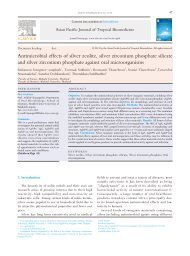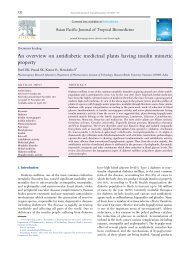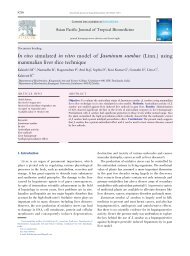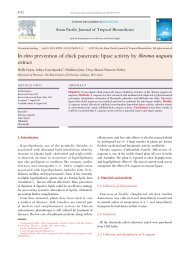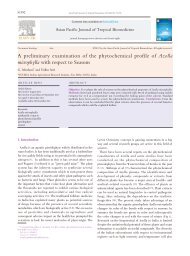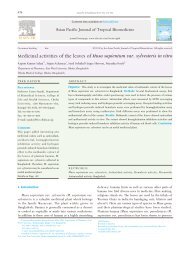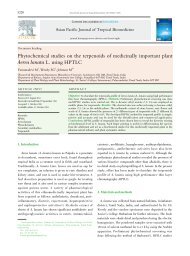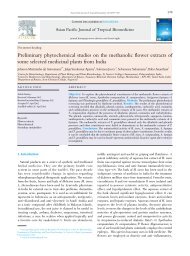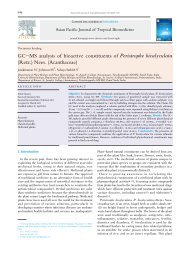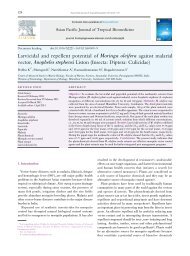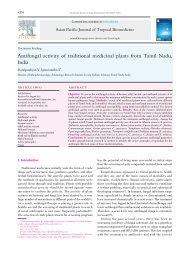Pharmacological properties of Datura stramonium L. as a - Apjtb.com
Pharmacological properties of Datura stramonium L. as a - Apjtb.com
Pharmacological properties of Datura stramonium L. as a - Apjtb.com
Create successful ePaper yourself
Turn your PDF publications into a flip-book with our unique Google optimized e-Paper software.
1004<br />
are black, kidney shape and flat[9,10]. Fruits are <strong>as</strong> large <strong>as</strong><br />
walnuts and full <strong>of</strong> thorns (hence the English name “thorn<br />
apple”) (Figure 1c). The plant is strong narcotic, but h<strong>as</strong> a<br />
peculiar action on the human which renders it very valuable<br />
<strong>as</strong> medicines. The whole plant is poisonous and the seeds<br />
are the most active; neither dying nor boiling destroys the<br />
poisonous <strong>properties</strong>. The symptoms <strong>of</strong> acute Jimsonweed<br />
poisoning included dryness <strong>of</strong> the mouth and extreme<br />
thirst, dryness <strong>of</strong> the skin, pupil dilate ion, impaired vision,<br />
urinary retention, rapid heartbeat, confusion, restlessness,<br />
hallucinations, and loss <strong>of</strong> consciousness[2].<br />
4.2. Distributions<br />
D. stromonium is probably originated in C<strong>as</strong>pian Sea<br />
territories and spreaded to Europe in the first century. At<br />
present it grows in w<strong>as</strong>te places in Europe, Asia, America<br />
and South Africa. D. stromonium is cultivated in Germany,<br />
France, Hungary, South America and throughout the<br />
world[8].<br />
4.3. Cultivation and collection<br />
Thorn apple is e<strong>as</strong>ily cultivated, growing well in open,<br />
sunny situation. It flourishes in most moderately good soil<br />
but grows best in calcareous rich soil, or in a good sandy<br />
loam, with leaf mould added. Seeds are sown in open in<br />
May, in drill 3 feet apart, barely covered. Sown thinly, <strong>as</strong><br />
the plants attain a good size and grow freely from seed.<br />
Thin out the young plants to a distance <strong>of</strong> 12 to 15 inches<br />
between each plant in the drill. The soil should be kept free<br />
from weeds in the early stages. If the summer is hot and<br />
dry, give a mulching <strong>of</strong> rotted cow-manure. If grown for leaf<br />
crop, the capsule should be picked <strong>of</strong>f <strong>as</strong> soon <strong>as</strong> formed,<br />
<strong>as</strong> in a wind the spines tear the leaves. In August the plant<br />
reaches to a hight <strong>of</strong> 1 meter and bears flowers and fruits.<br />
In the end <strong>of</strong> August stems with leaves and flowering tops are<br />
collected and dried <strong>as</strong> soon <strong>as</strong> possible at 45 °C to 50 °C. The<br />
leaves should be gathered when the plant is in full bloom<br />
and carefully dried. They are generally harvested in late<br />
summer. In August, the crop is cut by the sickle on a fine<br />
day in the morning, after the sun h<strong>as</strong> dried <strong>of</strong>f the dew, and<br />
the leaves are stripped from the stem, dried carefully <strong>as</strong><br />
quickly <strong>as</strong> possible[8-10].<br />
5. Ethanomedical uses<br />
Plant derived drugs <strong>com</strong>e into use in the modern medicine<br />
through the uses <strong>of</strong> plant material <strong>as</strong> indigenous cure in<br />
folklore or traditional systems <strong>of</strong> medicine. The leaves<br />
<strong>of</strong> D. stromonium L. are used for the relief <strong>of</strong> headache<br />
and vapours <strong>of</strong> leaf infusion is used to relive the pain <strong>of</strong><br />
rheumatism and gout. The smoke from the burning leaf is<br />
inhaled for the relief <strong>of</strong> <strong>as</strong>thma and bronchitis. European<br />
remedy <strong>of</strong> D. stromonium for haemorrhoid is to steam the<br />
part over boiling water containing leaf. The fruit juice is<br />
Priyanka Soni et al./Asian Pac J Trop Biomed 2012; 2(12): 1002-1008<br />
applied to the scalp for the treatment <strong>of</strong> falling hair and<br />
dandruff. It is also applied to smooth painful wounds<br />
and sores. Seeds and leaves <strong>of</strong> D. stromonium were used<br />
to sedate hysterical and psychotic patients, also to treat<br />
insomnia. D. stromonium w<strong>as</strong> used <strong>as</strong> hallucinogenic<br />
drug. It is also used to relax the smooth muscles <strong>of</strong> the<br />
bronchial tube and <strong>as</strong>thmatic bronchial sp<strong>as</strong>m. It w<strong>as</strong><br />
reported that D. stromonium w<strong>as</strong> used internally to treat<br />
madness, epilepsy and depression. Externally it forms the<br />
b<strong>as</strong>is <strong>of</strong> ointment for burns and rheumatism[12]. It is also<br />
used in the treatment <strong>of</strong> parkinsonism and hemorrhoids. Its<br />
leaves, applied after ro<strong>as</strong>ting, are useful in relieving pain.<br />
The bitter narcotic plant relieves pain and encourages the<br />
healing process. The seeds <strong>of</strong> the plant are medicinally the<br />
most active. Externally, the plant is used <strong>as</strong> a poultice in<br />
treating fistul<strong>as</strong>, abscesses wounds and severe neuralgia.<br />
Scopolamine is also found in the plant, which makes it<br />
a potent cholinergic-blocki hallucinogen that h<strong>as</strong> been<br />
used to calm schizoid patients. Its leaves, containing<br />
hyoscyamine and atropine, can be used <strong>as</strong> an immensely<br />
powerful mind-altering drug. The seeds <strong>of</strong> <strong>Datura</strong> are<br />
analgesic, anthelmintic and anti-inflammatory and <strong>as</strong> such,<br />
they are used in the treatment <strong>of</strong> stomach and intestinal<br />
pain that results from worm infestation, toothache, and fever<br />
from inflammation. The juice <strong>of</strong> its fruit is applied to the<br />
scalp, to treat dandruff and falling hair. The growing plant<br />
works <strong>as</strong> an insect repellant, which protects neighboring<br />
plants from insects[2]. D. stromonium is mostly used <strong>as</strong><br />
anthelmintics and antipar<strong>as</strong>itic in Marche, Abruzzo and<br />
Latium. Records <strong>of</strong> continued use <strong>of</strong> the plant in these<br />
sectors w<strong>as</strong> collected from farmers and shepherds (mostly<br />
old people)[4,13].<br />
6. Phytochemicals<br />
The major tropane alkaloids hyoscyamine and scopolamine<br />
and several minor tropane alkaloids have been identified<br />
in <strong>Datura</strong> species. Typical examples <strong>of</strong> minor alkaloids in<br />
D. <strong>stramonium</strong> are tigloidin, aposcopolamine, apoatropin,<br />
hyoscyamine N-oxide and scopolamine N-oxide17-20. 6<br />
覾-ditigloyloxytropane and 7-hydroxyhyoscyamine are<br />
reported for the first time in this species[2].<br />
Distribution <strong>of</strong> hyoscyamine and scopolamine in D.<br />
stromonium w<strong>as</strong> studied. The production <strong>of</strong> hycyamine and<br />
scopolamine in D. stromonium h<strong>as</strong> been investigated in the<br />
different plant parts, at different stages <strong>of</strong> their life cycle.<br />
The maximum contents were found in the stems and leaves<br />
<strong>of</strong> young plants, hyocyamine being always the predominate<br />
<strong>com</strong>ponent. These <strong>com</strong>pounds were included in many<br />
pharmacopie<strong>as</strong> because <strong>of</strong> their anticholinergic activities[4].<br />
D. stromonium contain variety <strong>of</strong> alkaloids including<br />
atropine, hyoscamine and scopolamine[14].<br />
Sixty-four tropane alkaloids have been detected from<br />
D. <strong>stramonium</strong>. Two new tropane alkaloids, 3-phenylacetoxy-6,<br />
7-epoxynortropane and 7-hydroxyapoatropine were tentatively<br />
identified. The alkaloids scopoline, 3-(hydroxyacetoxy) tropane,



